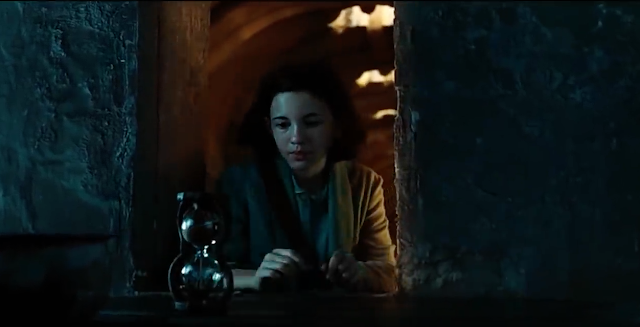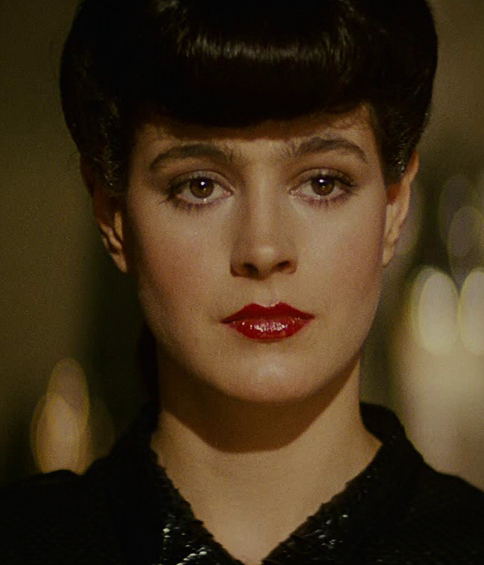Baby Driver: The opening credits
Wright's one shot opening credits begins as a low angle shot showing the height of the building Baby is about to come out of. We can see the words Baby driver as the non diegetic music begins.However as this pans down and becomes a mid tracking shot we realise that the music is actually internal diegetic sound as only Baby can hear it.
This sequence is like a classic dance break from a musical because the way Baby walks round the streets of Atlanta is to the rhythm and beat of the music. The mise-en-scene is very important in adding to the smooth feel of the dance number because as Baby passes certain parts of the road it mimics parts of the song we are listening to. The frame above shows the verb move on the parking machine which is on his left. This particular line from is "move it to the left". Following Baby down the road, he grooves to the beat of the song, an ordinary thing to do but this contrasts his next action which is to spin round facing the wall so that the word "right" gratified there is visible on his right. This word simultaneously occurs in the song proving that his actions in moving towards the writing is his form of dancing and expressing the music. The further we follow Baby the larger and more obvious the connections are to the music. He even dances round a lamppost as the song goes "whole lotta soul"
This sequence involving the lamppost allows the audience to see that the dance break is in similar tradition to that of a Hollywood musical because as he dances round it the passers by aren't distracted by the weird goings on. They act as if it is normal, as is often the case when stars break out into song and dance on a street in an ordinary musical. The internal diegetic sound that we hear is no noticeably building up with the addition of diegetic sounds caused by the mise-en-scene. This includes people shouting; the beats from a radio; the roar of a motorbike and the hammering of a pneumatic drill. This shows us that although we are following Baby's dance sequence the real music is created from the random incidental noises that build onto the song. The other moment where Baby dances for real is when he does the Harlem Shuffle, the name of the song that has been dancing to the whole time.
This is the end of the first part of the routine as after Baby emerges from the coffee shop the mood has changed considerably as he sees a policeman. He is less focused on enjoying the song which is still playing through his earphones and more concerned with returning to the gang without being scene, retracing his steps while the mise-en-scene is continually used to display quotes from the song.The scene ends with Baby getting safely back to the gang at the same time as the song finishes.
This sequence is like a classic dance break from a musical because the way Baby walks round the streets of Atlanta is to the rhythm and beat of the music. The mise-en-scene is very important in adding to the smooth feel of the dance number because as Baby passes certain parts of the road it mimics parts of the song we are listening to. The frame above shows the verb move on the parking machine which is on his left. This particular line from is "move it to the left". Following Baby down the road, he grooves to the beat of the song, an ordinary thing to do but this contrasts his next action which is to spin round facing the wall so that the word "right" gratified there is visible on his right. This word simultaneously occurs in the song proving that his actions in moving towards the writing is his form of dancing and expressing the music. The further we follow Baby the larger and more obvious the connections are to the music. He even dances round a lamppost as the song goes "whole lotta soul"
This sequence involving the lamppost allows the audience to see that the dance break is in similar tradition to that of a Hollywood musical because as he dances round it the passers by aren't distracted by the weird goings on. They act as if it is normal, as is often the case when stars break out into song and dance on a street in an ordinary musical. The internal diegetic sound that we hear is no noticeably building up with the addition of diegetic sounds caused by the mise-en-scene. This includes people shouting; the beats from a radio; the roar of a motorbike and the hammering of a pneumatic drill. This shows us that although we are following Baby's dance sequence the real music is created from the random incidental noises that build onto the song. The other moment where Baby dances for real is when he does the Harlem Shuffle, the name of the song that has been dancing to the whole time.
This is the end of the first part of the routine as after Baby emerges from the coffee shop the mood has changed considerably as he sees a policeman. He is less focused on enjoying the song which is still playing through his earphones and more concerned with returning to the gang without being scene, retracing his steps while the mise-en-scene is continually used to display quotes from the song.The scene ends with Baby getting safely back to the gang at the same time as the song finishes.





Comments
Post a Comment